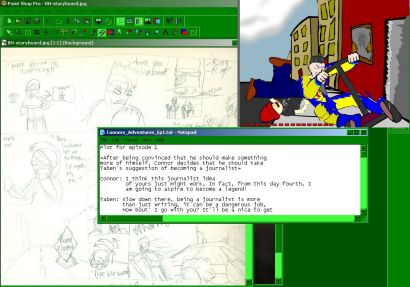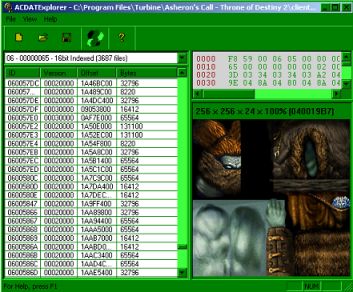User:Connorthecraftmaster/Connor's Adventures in Dereth
Connor's Adventures in Dereth
This is an animated series that created by Ryan Roye (Tanadrine Studios) that uses the images, content and lore of Asheron's Call as a basis for the content of the show. The models and props used were purposely fashioned to look as much like the game as possible. The ideologies used are not set in stone and may deviate from the game's actual portrayal of certain aspects of the game. For example, game lore suggests that Derethians hate Viamontians and vice versa, this is not present with the characters Connor and Taben, who are Viamontians.
Plot
The basic idea is that Connor the craftmaster is a once-famous book writer/publisher who has a dwindling fanbase and is fading into obscurity. His funds are low, and his lowered fanbase has him feeling down. It is only after his best friend, Taben Clearwater, suggests that he become a journalist that he decides to set out on an adventure which will help him reclaim his fame.
Production
The game engine was not used to animated this series. Rather, the models/objects/backgrounds were reconstructed via a 3d program called Lightwave to bring the characters to life. The following tools were used to create the videos.
Lightwave (3D model/animation)
Audacity (Sound editing/Sound extraction)
Windows Movie Maker (Post render video setup)
Paint Shop 6 (image editor/artwork)
ACDATExplorer (Extracting images/sounds from game)
the following article, previously posted on the now defunct ACforsaken.com, best describes the processes required to make a video.
"I figured I’d throw something in before the completion of my first official episode of Connor’s Adventures in Dereth… a behind the scenes look in how all this got started, what I do to make it happen, and so on and so forth.
So, here you have it….
From start to finish:
I had a pretty big challenge ahead of me. Armed with only my semi-artistic background, previous animation experience (2d via flash), and some experience with voice acting, and some other misc skills like very basic music production, I had a strong desire to make something using AC’s graphics. Why? Because it’s freakin’ classic! Not only that, but I felt this was the perfect opportunity to finally get into 3d animation and modeling because AC’s graphics and textures are simple but effective. Given that all of the models in AC are segmented so that they can move, this made my job that much easier. I’ve never been a fan of sacrificing animation quality for sheer detail… I just don’t understand it. It’s like where gaming is headed, all people seem to care about is how detailed it looks… not whether it actually accomplishes what it sets out to do. Games aren’t about gameplay anymore and animation isn’t about animation quality anymore… eh, it’s just not my cup of tea I suppose, to each their own.
Normally, to kick things off I make up a storyboard and a typed or written script to organize my animations. Obviously, it helps me make sure I have the shots/views I want… it’s easier to change a storyboard than it is a finished animation. However, this project was different because I used 2d backgrounds pulled directly from the game (more on that later), which pretty much eliminated the need to do this.
For those wondering, the pic below depicts “Totally Awesome Man”… a project I never finished (I stopped animating at 6 minutes, yikes!)… maybe sometime way down the line I’ll have the patience to do it, but… meh.
So, to start I got my hands on a copy of Lightwave, the program I’m using to create these animations. It’s one powerful tool, but of course, that makes it a complex program… needless to say I stumbled my way through the first pilot episode, making mistakes here and there that cost me hours upon hours of time, doing things inefficiently because of my lack of knowledge, etc. I normally learn programs by probing and prodding every control available, seeing what it does and how it works… well, it’s not always obvious until it’s too late to fix.
AC’s models have a very low poly count, so in essence, I began with simple boxes and shaped them into anything I needed. The method I used was very much like sculpting. The various body parts for the actors and props for scenery were all made by shaped boxes where I was subdividing then manipulating the polygons, edges and points to get the look I wanted. It’s a shame I couldn’t use the actual AC models, but I did manage to grab various textures to help solidify the look, thanks to ACDATE Explorer by Net-Marks Software.
So, I had finished creating my new model of Connor… but then I found out about the dreaded process of “rigging”, “weights”, and “Skelegons”, which are pretty much the bones of any character in any 3d program. This allowed me to manipulate my characters with decent precision, but it was tedious and getting simple things done was taking way, WAY longer than I liked. Making a simple walk animation was painful, inaccurate, or both, and I couldn’t re-use the animation. In this pic, you’ll notice I decided to make connor look even wimpier than his AC counterpart.
This is when I found out about inverse kinematics… simple put, it’s freakin’ amazing. I found out that just by creating 8 distinct points that I move around the character with, I could manipulate multiple body parts or objects at once which saved me tons of time animating. To put it in other words, inverse kinematics plants a particular body part in place until you decide to move it with a keyframe(a frame where something changes).This tool literally turns a 3 hour job into a 30 minute one. Since the pilot episode I’ve found out about other tools that enable me to re-use certain repetitive animations like walking or running a long distance, which definitely helps for certain shots. (The diamonds are like puppet strings, I move them and the jointed items move with them)
Then I ran into the problem of backgrounds… there was absolutely no way I’d be able to get anything done if I 3d-rendered every single area in AC. AC is a vast world, and putting together entire towns and duplicating AC’s vast landscape wouldn’t produce the feel I wanted, especially at my newb-like experience level. You don’t really appreciate the sheer amount of detail the Turbine team put into their environments until you really look at what’s there. So, I thought back to games like Alone in the Dark, Final Fantasy VIII, Knight’s Chase, and Resident Evil to name a few. These games all had one thing in common: They used 2d backgrounds. Yes, all the backgrounds you see in that pilot are nothing more than flat boards with pictures of various places of AC on them. To make the characters stand behind a counter in ac, I just make an identical overlay that covers their lower torso that looks exactly like the background. Yeah, really, take a look! (See that camera below? Everything you see is displayed through that.)
Pretty tacky when viewed this way isn’t it? Of course, this limits me in the fact that I must take a new picture in-game every time I want a new shot, which can get tedious. Eventually, I’d like to introduce at least a few 3d backgrounds so I can move the camera around and really give the characters room to move. One might ask how I eliminated my avatar in certain shots… thankfully, I’m also pretty adept in paint shop, so I can make things disappear easily enough with some smudging, copy-pasting and pixel smoothing.
So… that pretty much just leaves the voice acting part. Audacity is a free program I *strongly* recommend for anyone needing basic audio editing software… the creator of this program is a genius. It may not be impressive looking, but with it, I can manipulate my voice in ways that enable me to have more characters with fewer voices. I can pitch my voice up and down without speeding or slowing my speech, manipulate how loud or soft it is, etc etc. You just cannot do voice acting without some tool like this. Having a decent sound card or a USB based recording device also helps greatly, if you record straight from your sound card and it’s a cheap one, more often than not you’ll get unwanted feedback which ranges from loud buzzing to echoing. Onboard sound cards are the worst… yuck! It sucks, because when I need voice actors to do a voice I can’t mimic myself, more often or not they are perfect for the role but don’t have the equipment to record their work. Another thing about voice acting… there’s a reason why they almost always voice act an animation BEFORE animating it… it not only drives how the characters will move while talking, but it’s so much easier to change if you’re not satisfied with it. For this project, I’m able to work without character movement storyboards because in essence, the voices drive the animation. Having a full library of AC’s sounds also will help keep the game’s feel in place.
I can’t tell you how long an animation takes, because for my first video, the majority of my time was spent trying to figure out how to get something to do whatever and being frustrated trying to find resources online to solve my problems. As time goes on, my animation process will be much faster and better than before. Things go so much more smoothly when you actually know what you’re doing! I can sympathize with new Turbine staff that have had to “hit the ground running” with learning the proprietary software of AC they now manage… it’s no easy task!!
Anyways, that’s pretty much it. As of this writing I’m about 65% done with my video so keep an eye out for it. The runtime should be around 5 minutes given I don’t run into any problems and get my guest voice actors work in time. I hope to eventually make this a weekly or bi-weekly thing. Later, book club fans!"
Episode List
<youtube v="gefWQ-LbdRU"/>
<youtube v="DwIl1apqlwQ"/>
<youtube v="D2jHJX0hr0U"/>




